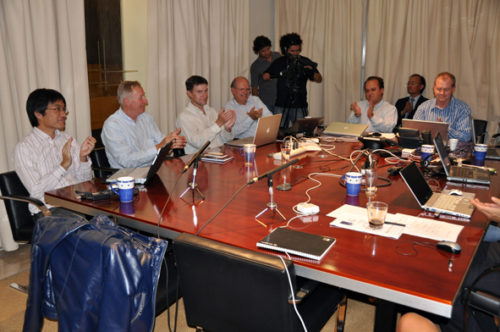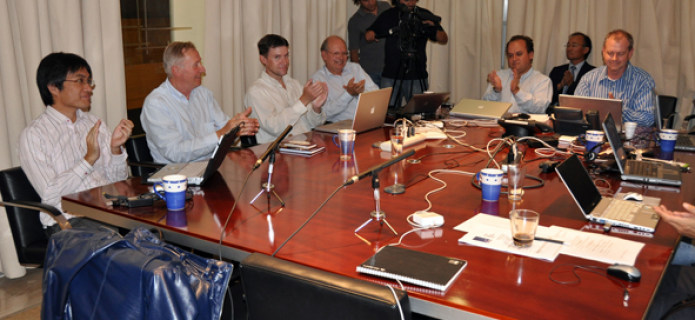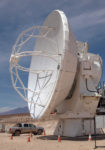ALMA observatory equipped with its first antenna
ALMA will initially comprise 66 high-precision antennas, with the option to expand in the future. There will be an array of fifty 12-meter antennas, acting together as a single giant telescope, and a compact array composed of 7-meter and 12-meter diameter antennas.
With ALMA, astronomers will study the cool Universe – the molecular gas and tiny dust grains from which stars, planetary systems, galaxies, and life itself are formed. ALMA will provide new, much needed insights into the formation of stars and planets, and will reveal distant galaxies in the early Universe, which we see as they were over ten billion years ago.
The first 12-meter diameter antenna, built by Mitsubishi Electric Corporation for the National Astronomical Observatory of Japan, one of the ALMA partners, has just been handed over to the observatory. It will shortly be joined by North American and European antennas.
“Our Japanese colleagues have produced this state-of-the-art antenna to exacting specifications. We are very excited about the handover because now we can fully equip this antenna for scientific observations,” said Thijs de Graauw, ALMA Director.
Antennas arriving at the ALMA site undergo a series of tests to ensure that they meet the strict requirements of the telescope. The antennas have surfaces accurate to less than the thickness of a human hair, and can be pointed precisely enough to pick out a golf ball at a distance of 15 km.
"ALMA is an ultimate radio telescope at millimeter and submillimeter wavelengths and will provide high-quality maps of the universe that have never been achievable before.
ALMA is not only a very powerful telescope for astronomers but also will bring all humanity a new cosmic view.", said Satoru Iguchi, ALMA-J Project Manager.
This antenna handover is a major milestone, as the observatory team can now proceed with integrating the rest of the components, including the sensitive receivers that will collect the faint cosmic signals from space.
The antennas are tested at the Operations Support Facility, at an altitude of 2900 m, before being moved to the plateau of Chajnantor at 5000 m. The Operations Support Facility will also be the observatory’s control centre.
ALMA is being built on the Chajnantor plateau, high in the Chilean Andes, because the site’s extreme dryness and altitude offer excellent conditions for observing the submillimetre-wavelength signals for which the telescope is designed.
In addition, the wide plateau at Chajnantor offers ample space for the construction of the antenna array, which is spread out and linked together over distances of more than 16 kilometres.
“The ALMA antennas must withstand the harsh conditions at Chajnantor with strong winds, cold temperatures and a thin atmosphere with half as much oxygen as at sea level. This forbidding environment also poses challenges for the workers building ALMA,” said de Graauw.
The antennas, which each weigh about 100 tons, can be moved to different positions in order to reconfigure the ALMA telescope. This will be carried out by two custom-designed transporters, each of which is 10 metres wide, 20 metres long, and has 28 wheels.
The ALMA Project is a partnership between the scientific communities of East Asia, Europe and North America with Chile.
Images:

- The first ALMA antenna to be handed over to the observatory, pictured here at the ALMA Operations Support Facility. This state-of-the-art 12 m diameter antenna was manufactured by Mitsubishi Electric Corporation.
Credit: (C) ALMA (ESO/NAOJ/NRAO).

- The official "Acceptance of the First Antenna by the ALMA Observatory" took place at the Licancabur Meeting Room in the JAO Office in Santiago, Chile. From left to right: Satoru Iguchi,Thijs de Graauw, Joseph McMullin, Richard Hills, Pedro Ramírez, Ryusuke Ogasawara, Michael Rodriguez.
The assistants (among others) were:
1. Thijs DE GRAAUW,
ALMA Director
2. Tetsuo HASEGAWA,
ALMA Deputy Project Manager
3. Richard MUROWINSKI,
ALMA Project Engineer
4. Michael RODRIGUEZ (Chairman)
System Engineering & Integration
Product Assurance
5. Richard PRESTAGE
Head of Technical Services
6. Ryusuke OGASAWARA
NAOJ Representative
7. Satoru IGUCHI
ALMA-J Project Manager
8. Junji INATANI
ALMA-J Antenna IPT
Videos:
A video related to this acceptance is available on the ALMA Observatory website: www.almasite.alma.cl ; at the section visuals/videos. Enjoy it !
Notes for editors:
ALMA will be the leading astronomical instrument for observing the cool Universe – the molecular gas and dust that constitute the building blocks of stars, planetary systems, galaxies, and of life itself.
ALMA will operate at wavelengths of 0.3 to 9.6 mm. At these wavelengths, a high, dry site is needed for the telescope to be able to see through the Earth’s atmosphere. This is why ALMA is being built on the 5000 m high plateau of Chajnantor in the Atacama region of Chile. ALMA will offer unprecedented sensitivity and resolution. The 12 m antennas will have reconfigurable baselines ranging from 15 m to 16 km. Resolutions as fine as 0.005 arcseconds will be achieved at the shortest wavelengths – a factor of ten better than the Hubble Space Telescope.
The Atacama Large Millimeter/submillimeter Array (ALMA), an international astronomy facility, is a partnership of the European Organisation for Astronomical Research in the Southern Hemisphere (ESO), the U.S. National Science Foundation (NSF) and the National Institutes of Natural Sciences (NINS) of Japan in cooperation with the Republic of Chile. ALMA is funded by ESO on behalf of its Member States, by NSF in cooperation with the National Research Council of Canada (NRC) and the Ministry of Science and Technology (MOST) in Taiwan and by NINS in cooperation with the Academia Sinica (AS) in Taiwan and the Korea Astronomy and Space Science Institute (KASI).
ALMA construction and operations are led by ESO on behalf of its Member States; by the National Radio Astronomy Observatory (NRAO), managed by Associated Universities, Inc. (AUI), on behalf of North America; and by the National Astronomical Observatory of Japan (NAOJ) on behalf of East Asia. The Joint ALMA Observatory (JAO) provides the unified leadership and management of the construction, commissioning and operation of ALMA.
Contacts:
William Garnier
ALMA Education and Public Outreach Officer
Joint ALMA Observatory, Chile
Phone: +56 2 467 6119
E-mail: [email protected]
Kenichi Tatematsu
ALMA-J Project Director
[email protected]


